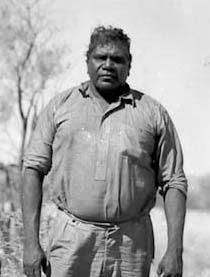Albert Namatjira
(1902 to 1958)

Source: National Library of Australia, NLA an22839230
Albert Namatjira, born on Hermannsburg Mission in 1902 of Aranda parents, became, in his lifetime, the most well-known and admired Aboriginal person in Australia. For a time, he was held up as an example of the success of the assimilation policy.
Artist Rex Battarbee had, in response to Albert's interest, taught him the principles of landscape painting in watercolours. Exhibitions initially arranged by Battarbee were a sell-out and, by 1954, Albert was presented to the Queen and had held exhibitions in Adelaide, Sydney and Melbourne.
Albert had been baptised when he was three, when his parents converted to Lutheran Christianity. He was also, however, initiated into manhood according to Aranda traditions. When he was eighteen he eloped with Ilkalita, and initially lived outside the Hermannsburg Mission as his wife was not only a member of a kinship group forbidden to him, but not a Christian. On their return to the Mission in 1923 with their three children Enos, Oscar and Maisie, Ilkalita converted to Christianity, taking the name Rubina. They settled in Hermannsburg, and over the next two decades Rubina gave birth to seven more children.
The material rewards which flowed as a result of Albert's artistic success - a truck to make his painting trips easier, money and the goods it could purchase in Melbourne or Sydney - were shared amongst his kin folk according to cultural expectation.
As the wealth flowed in, however, Albert grew increasingly troubled. In 1954 he attempted to buy land in Alice Springs to build a house, but was refused. At this time, under the Aboriginals' Ordinance, he did not have the rights of other Australian citizens.
When the Northern Territory Welfare Ordinance came into operation in 1957, Albert Namatjira's name was not on the list of wards who would be controlled by this legislation. This meant that he was an Australian citizen. He was now permitted to drink alcohol, but not with his relatives who were wards of the state. When a young woman was killed as a result of a drinking party at his camp at Morris Soak, Albert was back in the headlines, this time as the possible supplier of the alcohol which led to the drunken fight that resulted in her death. Some months later, Albert was charged with allowing Henoch Raberaba, a relative, access to a bottle of rum. He was found guilty and sentenced to six months in gaol. An appeal failed and Albert served a reduced three-month sentence at Papunya Reserve.
Albert Namatjira was broken by these events. Although his sentence was reduced for good behaviour, and he was reunited with his wife of 38 years, he seemed to have lost the desire to paint. Less than a year after his release, he died of a heart attack. The Australian public expressed shock and outrage at the time of his trial and his subsequent death, which many considered was not unrelated to the earlier sentence.
Further reading
Nadine Amadio, Albert Namatjira: The Life and Work of an Australian Painter, Macmillan, South Melbourne, 1986
Vincent Namatjira, Albert Namatjira, Magabala Books, Broome, 2021 (children’s book)
383336
- 391528
- 391534
- 382876
- 383008
- 383424
- 391546
- 382776
- 382880
- 391556
- 391562
- 391568
- 391580
- 391574
- 391586
- 384354
- 383635
- 391596
- 382884
- 383268
- 383959
- 383044
- 391608
- 391614
- 384358
- 383256
- 391624
- 382964
- 391680
- 391686
- 383658
- 382888
- 391696
- 383260
- 382780
- 391706
- 384213
- 383837
- 383264
- 391718
- 383841
- 382968
- 391728
- 383704
- 383012
- 382748
- 382892
- 383570
- 383316
- 391748
- 383048
- 383754
- 383666
- 383104
- 391763
- 383662
- 384061
- 384065
- 391774
- 391780
- 391785
- 383188
- 383708
- 391795
- 391801
- 391807
- 383336
- 384362
- 382856
- 383272
- 383963
- 391819
- 382896
- 391825
- 382972
- 383296
- 383080
- 383758
- 383108
- 384069
- 391851
- 391857
- 391863
- 391869
- 382900
- 384366
- 382784
- 391882
- 391888
- 382904
- 383712
- 391900
- 383084
- 391908